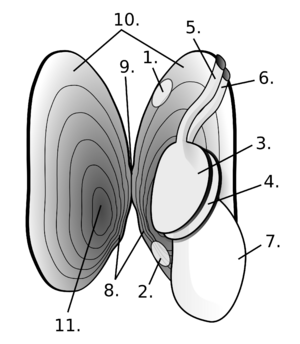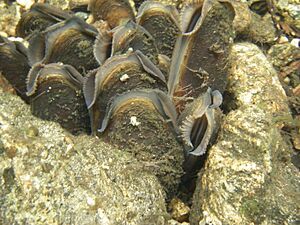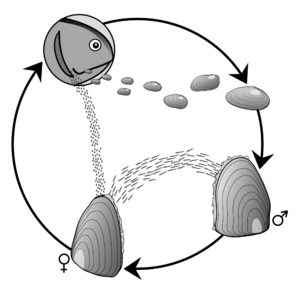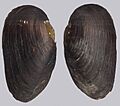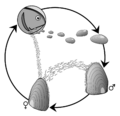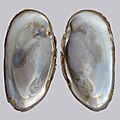Freshwater pearl mussel facts for kids
Quick facts for kids Freshwater pearl mussel |
|
|---|---|
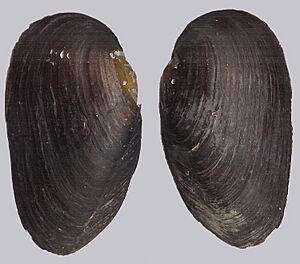 |
|
| The outside of a freshwater pearl mussel shell | |
| Conservation status | |
| Scientific classification | |
| Genus: |
Margaritifera
|
| Species: |
margaritifera
|
 |
|
| Where Margaritifera margaritifera lives in Europe. | |
The freshwater pearl mussel (Margaritifera margaritifera) is an endangered species of freshwater mussel. It's an aquatic bivalve mollusc, which means it's a soft-bodied animal with a shell made of two hinged parts. This special mussel belongs to the family Margaritiferidae.
Even though it's called the "freshwater pearl mussel," other types of freshwater mussels can also make pearls. Historically, people hunted these mussels to find pearls. Today, most pearls used in jewelry come from other mussel species raised on farms.
The inside of the freshwater pearl mussel's shell has a thick, shiny layer called nacre, also known as mother-of-pearl. This mussel can create beautiful, high-quality pearls. Scientists have discovered that these mussels can live for an incredibly long time, sometimes over 200 years! This makes them one of the longest-living animals without a backbone.
Contents
What Does It Look Like?
The freshwater pearl mussel is one of the oldest living invertebrates (animals without a backbone). The oldest one found in Europe was 134 years old!
Like all bivalve molluscs, this mussel has a shell with two parts that are joined together. It can close its shell tightly to protect its soft body inside. The shell is big, heavy, and long. When young, it's yellowish-brown, but it gets darker as it gets older. Older parts of the shell often look worn or corroded, which helps identify this species.
The inside of the shell is a pearly white, sometimes with pretty rainbow colors. The mussel also has a large, white, muscular 'foot'. This foot helps the mussel move slowly and bury itself in the sand or gravel at the bottom of its freshwater home.
Where Do They Live?
The freshwater pearl mussel lives in many parts of the Northern Hemisphere, across the Arctic and cooler regions. You can find them on both sides of the Atlantic Ocean, from western Russia and Europe to northeastern North America.
In North America, they live in eastern Canada and the New England area of the United States. In Europe, they are found in many countries like Austria, Belgium, France, Germany, and the United Kingdom.
Scotland, in Great Britain, is very important because it has more than half of the world's remaining freshwater pearl mussel populations that are still reproducing. However, illegal hunting for pearls has seriously harmed these populations. Because of this, the species is fully protected by law in the United Kingdom.
Sadly, in some places like Lithuania and Poland, these mussels have completely disappeared.
Their Home: Clean Rivers
Freshwater pearl mussels need clean, fast-flowing streams and rivers to survive. They live buried or partly buried in fine gravel and coarse sand, usually in water that is about 0.5 to 2 meters deep.
Clean gravel and sand are super important, especially for young mussels. If the river bottom gets clogged with mud or silt, the mussels can't get enough oxygen and will die.
Another key thing they need is a healthy population of fish like salmon and trout. These fish are vital because the mussels depend on them for part of their life cycle.
The Freshwater Pearl Mussel Life Cycle
These mussels can live for up to 130 years! Their life starts as a tiny larva, only about 0.6 to 0.7 millimeters long. An adult female mussel releases millions of these tiny larvae, called glochidia, into the water, usually between July and September.
These glochidia look like tiny mussels, but their shells are open. They snap shut when they find a suitable host fish. The hosts for freshwater pearl mussel larvae are young fish from the salmon family, like Atlantic salmon and sea trout. Most larvae don't find a fish and die. Only a few are breathed in by a salmon or trout and attach themselves to the fish's gills.
The glochidia live and grow on the fish's gills, which are rich in oxygen, until the next May or June. Then, they drop off. For the young mussel to grow successfully, it must land on clean gravel or sandy riverbeds.
Young mussels usually bury themselves completely in the sand or gravel. Adult mussels are often found with about a third of their shell showing. If they get dislodged, they can rebury themselves. They can also move slowly across sandy areas using their large, muscular foot.
The freshwater pearl mussel grows very slowly. It breathes in water through special tubes called siphons and filters out tiny bits of food. In the past, when these mussels were common, their filter feeding helped keep the river water clean, which was good for other river animals.
Mussels become adults and can reproduce when they are about 10 to 15 years old. They can then reproduce for over 75 years, producing about 200 million larvae in their lifetime. Inside the female mussel, fertilized eggs develop in a pouch on her gills for several weeks. When the water temperature or other environmental signals are right, the female releases the larvae into the surrounding water.

Threats and How We Help Them
The freshwater pearl mussel was once very common in rivers around the world, but now its numbers are dropping everywhere. In many places, they are almost gone. Scientists don't fully understand all the reasons for this decline, but changes and damage to their river homes are a big part of it.
Human activities like changing rivers, draining land, dumping sewage, dredging (removing sand or mud from the riverbed), and water pollution (like too many nutrients) all hurt these mussels. Anything that affects the number of their host fish, like introducing new fish species such as the rainbow trout, also harms the mussels.
Other introduced species, like the zebra mussel (Dreissena polymorpha), also directly affect freshwater pearl mussels. Zebra mussels can spread by attaching to boats and compete with the native mussels.
The freshwater pearl mussel is now fully protected in all European countries. Many efforts are being made to save them. These efforts include moving adult mussels to new areas, raising young mussels in special facilities, and releasing young trout (infected with mussel larvae) into small rivers. Most importantly, projects to restore their natural river habitats are helping a lot. Since salmon and trout are so important to the mussels' life cycle, protecting these fish is also key to saving the endangered freshwater pearl mussel.
Conservation Efforts
The LIFE R4ever Kent project is a big effort that started in January 2022. It aims to save and restore the freshwater pearl mussel population in the River Kent in the UK. The project also wants to improve existing breeding areas to make sure the mussels can survive for a long time.
The mussels in the River Kent were badly hurt by pollution, damaged habitats, and a lack of young mussels surviving naturally. This project works with other groups like the Environmental Agency and the Freshwater Biological Association. The River Kent is special because it's the only river in the UK where both the freshwater pearl mussel and the white clawed crayfish live together.
The goal is to increase the mussel population by 4,000 individuals and help them spread further in the River Kent Special Area of Conservation (SAC). They plan to bring in mussels from other healthy populations and improve breeding facilities. Scientists believe that the remaining populations in the River Kent are too small to survive on their own, so they need help from captive breeding programs. The project aims to breed over 4,000 young mussels for release. About 3,000 will be released when they are young, and 1,000 will be kept to grow larger before being released into the SAC.
Images for kids
-
The interior of the shell of Margaritifera margaritifera, showing the nacre



